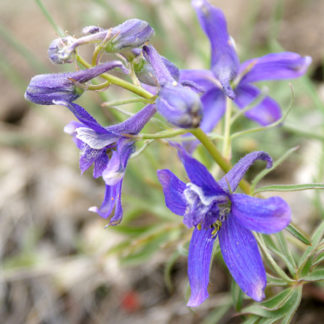exposed
Showing 13–24 of 60 results
-

Balsamorhiza sagittata / arrowleaf balsamroot
- large, bright yellow, sunflower-like blossoms in early spring
- very large, more or less triangular basal leaves
- leaves appear silvery, or grey-green due to leaf hairs
- on open, fairly dry hillsides and ridges, often with sagebrush
-

Bassia scoparia / burningbush
- large, annual herb (forb)
- leaves long-ish and narrow
- inflorescence a highly branched spike with teeny green/yellow flowers
- may form huge, invasive colonies
- whole plant turns red in fall
- a tumbleweed
- especially in disturbed areas and wastelands in the Valley
-

Carduus nutans / musk thistle
- quite large, very purple flower heads
- spiny everything... leaves, stems, bracts
- biennial - large rosette of nasty leaves in first year
- dandelion-like fruit that flies away like the down of a thistle
- disturbed lands... pastures, wastelands, roadsides, construction sites
-

Castilleja spp. / two yellow paintbrushes
- look like Indian paintbrushes (which they are), but yellow
- inflorescence bracts possibly lobed
- height ranges from less than 8" to about 15"
- subalpine, alpine and tundra habitats, in clumps or spread out
- linear leaves without lobes, 3 prominent veins
- red to maroon, hairy stems
-

Cercocarpus ledifolius / curl-leaf mountain mahogany
-

Cirsium scariosum / elk thistle
- usually tall, quite prickly thistle with deeply lobed, spiny leaves
- large, lavender (pink to purple) flowers hidden by the long leaves
- covered with white hairs giving it a silvery look overall
- in moist areas, in full sun
-

Collinsia parviflora / maiden blue-eyed Mary
- inconspicuous
- teeny blue and white flowers, singly or in small clusters
- reddish stems and buds more visible than the flowers
- wide variety of habitats, bare rocks to marshy fens
-

Corydalis aurea / scrambled eggs
- prostrate herb, up to 15" tall
- moist but well-drained soils, including on roadsides
- yellow tubular flowers, with spurs
- highly dissected leaves, blue-grey except when young
- fruits are pod-like, resembling peas or beans
-

Crataegus douglasii / black hawthorn
- slightly thorny shrub or small tree, to 30 feet
- often forms thickets
- broad leaves with toothed edges, clumped at ends of branches
- clumps of white, globe-shaped flowers in spring; prominent black anthers
- clumps of black "berries" in autumn
-

Crepis acuminata / tapertip hawksbeard
- leaves (diagnostic) - long; many deep triangular, pointed lobes; upright, grey-green; milky sap
- flowers - 5-10 rays, no disc florets; yellow; up to 70 per plant
- dry, open places in foothills; commonly with sagebrush
-

Dactylis glomerata / orchardgrass
- perennial bunchgrass
- branched inflorescence with lowest branch well below the others
- spikelets wedge-shaped, flattened in tight clusters
- florets green to red/purple tinged; grey-brown when seeds mature
- introduced and widespread, but not in wet areas
-

Delphinium bicolor / low larkspur
- short plant with a spike of purple flowers
- individual flowers have a pronounced spur out the back
- leaves are few, round, deeply lobed, about the size of a quarter
- widespread throughout the valley and on the hills
- appears and blooms soon after snowmelt
Showing 13–24 of 60 results